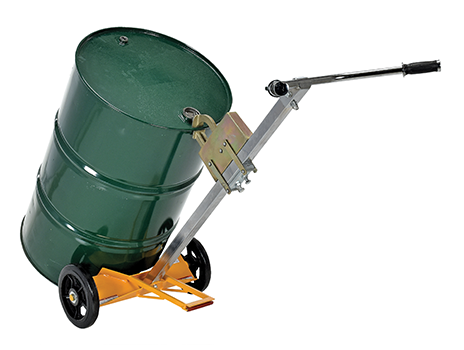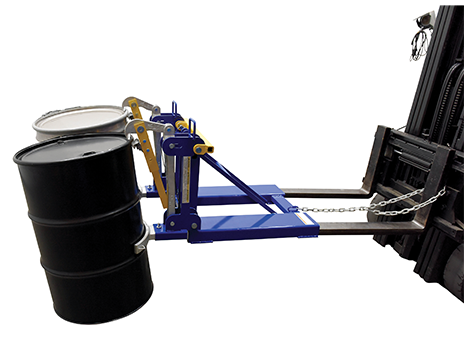Drumming Up Safety


SPRAY FOAM MAGAZINE – As spray polyurethane foam (SPF) contractors, we are all aware of the chemical exposure and general hazards associated with construction jobsites. However, one often overlooked daily activity is the proper handling and disposal of 55-gallon drums.
Injury risk
A fully loaded drum of SPF chemicals can weigh up to 600 lbs, creating significant challenges and risks when moving these heavy loads. If not handled properly, drums can cause a variety of injuries, including:
- Bruised, broken, or fractured fingers/hands: This can happen when fingers are pinched between drums on a pallet.
- Broken or crushed limbs: Full drums can tip and fall, causing serious injuries to lower legs and feet.
- Musculoskeletal disorders: Improper handling over the long term can lead to disorders affecting the spine, back, shoulders, or neck.
- Chemical Exposure: Depending on the contents, workers can be exposed to hazardous chemicals.

Handling practices
Unfortunately, many contractors engage in poor methods of handling drums. Poor handling practices can result from improper training or simply the need to get the job done quickly. Here are some common examples of poor practices that can exacerbate injury risks:
- Manually moving drums by hand: Balancing the load on the bottom edge and rolling them can lead to strains, poor posture, and increased risk of injury.
- Pulling or lifting drums manually: This can result in strain injuries, finger entrapment, crushed toes, and damage to the drum lid seal.
- Dropping drums into a horizontal position: Uncontrolled actions like pushing or tipping can lead to injuries.
- Decanting drums with a forklift: Lifting drums horizontally can cause them to slide off the forks, leading to potential damage or injury.
Contractors can take a few simple steps to minimize the risk of injury from handling drums. Here are some suggested best practices:
- Identify drum contents: Confirm if the drum contents are hazardous, corrosive, toxic, or flammable. Treat unlabeled drums as hazardous until positively identified.
- Use personal protective equipment (PPE): Depending on the drum contents, use gloves, eye protection, aprons, and other necessary PPE as required by the Safety Data Sheet (SDS). Safety shoes should always be worn when moving heavy drums.
- Secure drum components: Before moving, ensure bungs and lids are in place and secure.
- Estimate weight and get help if needed: Drums can weigh between 400-800 pounds. Use a forklift, hand truck, or drum cart designed for drum handling whenever possible.
- Use drum handling equipment: There are numerous devices designed specifically for handling 55-gallon drums. Specialized handcarts and forklift attachments are available to simplify drum handling. Gate lifts can eliminate the need for a forklift to move drums into a truck-mounted spray rig.
Drum leakage and disposal
With proper training and specialized equipment, the injury risk from drum handling can be reduced. However, there are other challenges with 55-gallon drums. Mishandling from shipping or improper storage can damage seals or cause punctures, leading to chemical leaks or spills. There are also specific OSHA requirements for leak protection for containers of 55-gallons or more containing flammable or toxic liquids.i
Before any drum is moved look around the drum to identify any leakage and ensure you are trained in the hazards of the chemicals and have the appropriate materials for cleanup. Review the SDS for the specific chemical.
Another challenge with chemical drums is proper disposal of empty drums. There are several important steps to follow. The American Chemistry Council’s Center for the Polyurethanes Industry publishes a guidance document on proper disposal of drums containing polyurethane chemicals.ii Here are some highlights:
- Use proper PPE: Ensure the PPE used is appropriate for the characteristics of the material previously in the drum.
- Ensure the drum is empty: Even empty drums can retain harmful residues. Observe all precautions listed in the SDS.
- Contact professionals: Use a professional drum re-conditioner, scrap metal recycler, or approved landfill for disposal. The Reusable Industrial Packaging Association (RIPA) can help you find a drum recycler (www.reusablepackaging.org)
- Decontaminate drums: Some recyclers may require decontamination of drums before acceptance.


TOP: Steel drum hand cart; BOTTOM: Steel drum forklift attachment
Properly decontaminated drums can be crushed to minimize volume before recycling. There are devices that contractors can use with or without a forklift to safely crush 55-gallon steel drums at their facility. Finally, SPF chemical drums should never be left at a jobsite, given away, or be re-purposed for any reason. Contractors are ultimately responsible for proper disposal of empty drums.
Alternative solutions – reducing risks, impact, and cost
Handling and disposing of drums and pallets pose significant risks and require proper training and equipment, not to mention additional time and expense. However, there are alternatives to the use of 55-gallon drums.
Bulk delivery of SPF chemicals is now available from one supplier, ideally suited for contractors with more than one spray rig. Tanker trucks from the supplier deliver MDI and resin chemicals, which are transferred to a supplier-owned bulk delivery tanks at the contractor’s facility. Daily requirements of SPF chemicals are transferred into plastic day tanks installed in each rig, eliminating the need for steel drums and drum pumps.
These alternatives can mitigate the risks associated with drum handling and disposal, though they require some investment in infrastructure. When steel drums are used, proper training and adherence to safety protocols remain essential to ensure worker safety and compliance.
i OSHA 1915.173(e) requires that all containers of 55 gallons or more capacity containing flammable or toxic liquid shall be surrounded by dikes or pans which enclose a volume equal to at least 35 percent of the total volume of the containers.
ii Disposal of Empty Drums Containing Polyurethane Chemicals, March 2016. https://www.americanchemistry.com/industry-groups/center-for-the-polyurethanes-industry-cpi/resource...
iii Industrial Steel Drum Institute – Perspectives on Packaging, Issue 8, December 3017. www.whysteeldrums.org
iv Spray Polyurethane Foam Insulation Products – EPD Background Report (Life Cycle Assessment Report prepared by Thinkstep (Sphera), October 2018.
About the Author
Richard S. Duncan, Ph.D., P.E served as technical director of SPFA from 2008-2020, and as executive director from 2020 to 2024. Currently as Technical Consultant to SPFA, he oversees all technical activities for the organization.
For use by SprayFoamMagazine.com & Spray Foam Magazine
Disqus website name not provided.










































